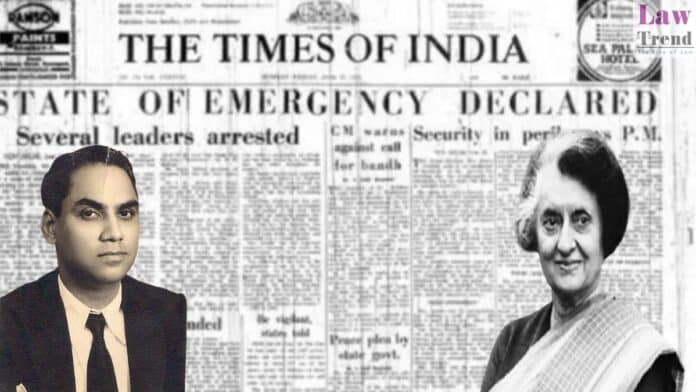June 12, 1975 exactly 50 years ago, Indira Gandhi received bad news before the sun even rose. Durga Prasad Dhar, his close advisor, died of a heart attack. Indira had called Dhar a few days ago from Moscow.
This was only the beginning of the bad news for the country’s powerful Prime Minister that day.
When the day arrived, the movement of the Prime Minister’s residence was unusual. Krishna Iyer Seshan, Indira Gandhi’s senior most secretary, was agitated. He was awaiting the Allahabad High Court’s decision on a election petition.

This petition was filed in opposition to Indira Gandhi’s election in the 1971 Lok Sabha elections. The petitioner was his election opponent, socialist leader Raj Narayan. The verdict was delivered by Justice Jag Mohan Lal Sinha.
From allurement to threats to postpone the decision, Justice Sinha received it all. He was even offered the position of Supreme Court justice, but all of his attempts failed.
In his book ‘The Inside Story of the Emergency,’ senior journalist Kuldip Nayar writes, “Every human being has a price, but Sinha was not one of them.” He couldn’t be persuaded or persuaded.
Justice Jag Mohan Lal Sinha, 55, arrived in court at 9:55 a.m. The Allahabad High Court’s Room 24 was jam-packed. A 258-page judgement was delivered by him, which he wrote despite all obstacles.
This Judgement was going to write the country’s fate in the coming years. Justice Sinha read the decision and stated, “The petition is allowed.”
The news reached the Prime Minister’s residence in Delhi within minutes. NK Seshan reached to Indira’s room. Outside the room stood his son, Rajiv Gandhi, to whom Seshan handed a piece of paper. On it was written, ‘Mrs. Gandhi unseated.’ Indira received the worst news of her political career from her son Rajiv.
Indira was found guilty of election rigging and her election from Rae Bareilly was cancelled by Justice Sinha. Indira Gandhi was barred from running for office for six years under the Representation of the Peoples Act. Indira received relief on five of the seven issues heard by the court, but she was stuck on two.
Justice Sinha stayed his own verdict for 20 days so that Indira could appeal to the Supreme Court and Congress could make an alternative arrangement for the post of Prime Minister. On June 23, 1975, Indira Gandhi appealed to the Supreme Court against this decision.
Following the court’s decision on June 12, cabinet ministers began pouring into Indira Gandhi’s residence at 1, Safdarjung Road. Everyone’s expressions were filled with rage. Indira Gandhi’s resignation was demanded by all opposition parties at the same time.
Indira Gandhi’s personal secretary, RK Dhawan, stated on television in 2015 that Indira Gandhi was ready to resign following the Allahabad High Court verdict.
In his book, Kuldip Nayar writes, “Indira sat behind closed doors with her family to decide what they should do next.” Both of his sons, Rajeev and Sanjay, were opposed to his resignation. Not even for a couple of days. Sanjay was enraged.
On the 13th day after the verdict, Indira declared a state of emergency in the country.
Meanwhile, opposition from the opposition was growing steadily. On June 14, all opposition parties joined forces to launch a nationwide anti-Indira campaign.
Meanwhile, the Supreme Court issued its decision on Indira’s petition on June 24. Indira was granted conditional relief. She was granted the right to participate in House debate, but she was still barred from voting.
Also Read
Even today, Justice Sinha serves as a model for judges. His single decision altered the country’s politics. In September 2021, the country’s then Chief Justice, NV Ramanna, said that Justice Sinha’s decision in June 1975 was an act of great courage.
On another occasion related to the Indira vs Raj Narayan case, Justice Sinha surprised everyone with his candour. Let us go back to the date of the Emergency. On March 18, 1975, a Prime Minister was about to appear in court for the first time in the country’s history. Indira Gandhi had only a few minutes to get to court. Then Justice Sinha addressed the audience, saying, “People in the court stand only when the judges come.” That is why, when the witness arrives, no one should stand.” This is exactly what happened when Indira Gandhi arrived. No one rose in his honour. Indira spent about 5 hours that day answering court questions.
Even before passing the verdict on June 12th, Justice Sinha demonstrated remarkable transparency. “The operative part of the judgement was typed in Sinha’s presence on June 11 itself, and apparently Sinha must have told his stenographer to ‘disappear’ at the same time,” writes Kuldeep Nayyar. Sinha kept his decision completely private.”
Justice Sinha and his wife had also vanished from their homes the night before the verdict, making it impossible for anyone to contact them. Clearly, Justice Sinha did not want the decision to be influenced in any way.







